We exercise for a number of reasons: to build muscle, lose weight, reduce stress, or maybe even to socialize and set aside “me time.” Working out is a great way to improve overall physical and mental health whether you are going on a morning walk or training for a marathon. However, if your goals for working out are focused on weight loss or high impact workouts in a short period of time, selecting workouts and specific exercises that increase your metabolic rate is a great way to begin.
It’s common knowledge that some people have a naturally higher base metabolic rate (BMR) than others, which means their bodies process the energy they consume from food at a faster rate. These folks generally can eat more food without gaining weight as quickly. But not everything is genetic. You have the ability to control many metabolic factors, and working out has the wonderful benefit of also boosting metabolism in two key ways.
First, in the short run, a person can train their heart rate by achieving a higher level of cardiovascular fitness (resulting in a lower resting heart rate) with high intensity interval training (HIIT) workouts. HIIT overall, requires more energy than less strenuous workouts in order to provide the working muscles with adequate energy. Increased cardiovascular efficiency represents an improved ability to deliver oxygen to the working muscles.This results in improved fat burn as fat requires more O2 to be metabolized than glucose (carbs). Essentially, HIIT workouts burn more calories in a short period of time by increasing the heart rate, then letting it slow down, then speeding it up again. This process provides a temporary metabolic boost and burns more calories in a short period of time.
Second, a person should work to build muscle — and the more muscle that person has in proportion to fat — the faster the body burns calories. Muscles need quite a bit of energy to function, and a person with more muscle, has a faster metabolism. Here are 5 workout recommendations to get your heart rate up and running as a starting point for metabolism boosting workouts.
How to do it: Get in a plank position, bend your elbows and jump your feet forward to meet your hands. From this position, quickly and aggressively put your hands in the air and jump at the same time. Then hop back down into the same position with your feet and hands meeting like a frog. Next, jump back into a plank. Then do it again. To add intensity to this move, try to pull your knees into your stomach and feet toward your bottom as you jump in the air.
The Gist: This is a fantastic exercise to raise your heart rate and activate as many muscles as possible for a full-body workout. Depending on your background, start with intervals of 20 to 45 seconds with a 10-15 second break. Do several sets starting with at least three sets.
How to do it: Get in a plank position and lift your right leg a couple inches off of the ground then pull your knee in towards your stomach, then place your knee back. Next, lift your left leg and do the same movement. Speed this movement up as if you are running with your hands on the floor.
The Gist: Like burpees, this is a full body workout that gets your heartrate up to burn calories quickly. Do these in intervals of 20 to 45 seconds with a 10-15 second break. Do several sets starting with at least three sets. Also, it’s a great idea to rotate between this exercise and burpees to activate slightly different muscle groups and keep things entertaining.
How to do it: Get in a wide legged stance, meaning place your legs slightly more open (about 6 inches) than when you are standing with your feet at shoulder-width length. Hold a kettlebell at the weight of your choosing (5 pounds and up). Then get in a low squat by leaning back as if you are sitting in a chair, The kettlebell should be resting in between your legs almost at the floor. Next, stand up by moving your hips forward as you swing your arms up, with control. This motion should take you smoothly back into the squatting position. Do this again as fast as you can and with as much control as possible. If you are swinging wildly, you could hurt your back or shoulders, and you will not be getting the full benefit of the workout.
The Gist: This is another great exercise to work into a HIIT routine. It targets so many upper and lower body muscle groups, you should be out of breath after one set. As with other HIIT exercises, these in intervals of 20 to 45 seconds with a 10-15 second break. Do several sets starting with at least three sets. Work this exercise into a routine with the others. Then test how your metabolism was affected with the Lumen metabolic tracker.
How to do it: This is a great exercise whether you are at the gym, in your neighborhood, or on vacation. For the gym, get on a treadmill and set to interval training. Most machines allow you to put in the speeds and hill heights you want for the sprints as well as the breaks. Rotate between a 45-second to 1-minute sprint, and then rest for about twice the period of time you sprinted. Resting in this situation fully depends on your running level – you could be jogging at a comfortable sustained pace or walking briskly. Do this routine for about 12 to 15 minutes.
For the outdoorsy types, find a hill and sprint it! Set a timer for 30-45 seconds, depending on vertical incline and your experience. Then switch to a light jog or a brisk walk for double the time you sprinted.

The Gist: For the runners out there, if your goal is to boost metabolism, HIIT interval running is a great change of pace. You are getting the heart rate up, which is what affects the metabolism. Sustained running at a comfortable pace does not have the same metabolic impact as HIIT running. If you’re not so sure about this whole HIIT sprinting thing, the Lumen metabolic tracker is a great tool to determine whether your metabolic rate has been positively impacted from HIIT sprints and how it is working.
How to do it: Weightlifting is a wonderful addition to any active person’s lifestyle, when done correctly with proper form. What does that mean? You need to determine a good base weight and what your goals are. An excellent way to do this is to book a few sessions with a trainer at a gym who can help you determine what weightlifting exercises best fit your goals and how much weight and how many reps to start at. Once you have that figured out, you can hit the weights on your own.

Some weightlifting exercises to target larger muscle groups include weighted deadlifts and squats, for the derriere and legs, and weighted chest presses. The general rule to build muscle is to do lower numbers of reps in a set, with three sets max. Generally, start with doing 10-12 reps in the first two sets at a weight that is somewhat challenging, meaning you feel the burn, but your form is very solid. For the last set, if your body feels up to it, add a little bit of weight (between 5 to 10 pounds), and go for doing just 8 reps. If you lose your form then there’s too much weight.
The Gist: Building up muscle over time will increase your metabolism in order to feed your growing muscles. The Lumen metabolic tracker is a perfect tool to determine whether your weightlifting routine has worked to improve your metabolic rate, but remember that building muscle takes time! So, do not expect your metabolism to immediately jump after one weightlifting session. You’ll need to work in some HIIT exercises for that type of immediate, though more temporary, boost.

Our Lumen editorial desk includes an in-house team of certified and registered nutritionists and dietitians, scientists, researchers, and writers.